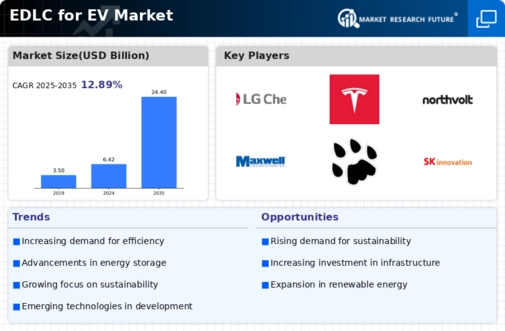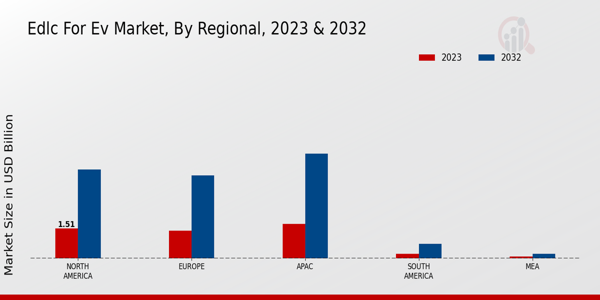Market Growth Projections
The Global EDLC for EV Market Industry is anticipated to experience substantial growth over the coming years. With a projected market size of 6.42 USD Billion in 2024, the industry is set to expand significantly, reaching an estimated 24.4 USD Billion by 2035. This growth trajectory indicates a strong demand for electric double-layer capacitors as the automotive sector increasingly adopts electric vehicles. The anticipated compound annual growth rate (CAGR) of 12.89% from 2025 to 2035 underscores the potential for innovation and investment in energy storage technologies. Such projections highlight the importance of EDLCs in supporting the transition to sustainable transportation.
Government Policies and Incentives
Government policies and incentives play a crucial role in shaping the Global EDLC for EV Market Industry. Many countries are implementing stringent regulations to promote electric vehicle adoption and reduce greenhouse gas emissions. Financial incentives, such as tax credits and rebates for EV purchases, encourage consumers to transition to electric mobility. Additionally, investments in charging infrastructure and research initiatives support the development of advanced energy storage technologies, including EDLCs. As these policies continue to evolve, they are likely to create a favorable environment for the growth of the EDLC market, with projections indicating a market size of 24.4 USD Billion by 2035.
Rising Demand for Electric Vehicles
The increasing global demand for electric vehicles (EVs) is a primary driver of the Global EDLC for EV Market Industry. As consumers and governments prioritize sustainability, the adoption of EVs continues to rise. In 2024, the market is projected to reach 6.42 USD Billion, reflecting a growing preference for cleaner transportation options. This trend is further supported by government incentives and regulations aimed at reducing carbon emissions. As more automakers commit to electrification, the demand for efficient energy storage solutions, such as electric double-layer capacitors (EDLCs), is likely to surge, thereby propelling the market forward.
Market Dynamics and Competitive Landscape
The competitive landscape of the Global EDLC for EV Market Industry is characterized by dynamic market forces and evolving consumer preferences. As more players enter the market, competition intensifies, leading to innovations in product offerings and pricing strategies. Established manufacturers are increasingly investing in research and development to enhance their product portfolios and maintain market share. This competitive environment encourages the development of advanced EDLC technologies that meet the diverse needs of electric vehicle manufacturers. As a result, the market is poised for robust growth, with a projected compound annual growth rate (CAGR) of 12.89% from 2025 to 2035.
Technological Advancements in Energy Storage
Technological innovations in energy storage systems significantly influence the Global EDLC for EV Market Industry. Recent advancements in EDLC technology, including improved energy density and faster charging capabilities, enhance the performance of electric vehicles. These innovations enable manufacturers to create more efficient and reliable energy storage solutions, which are essential for the growing EV market. As the industry evolves, the integration of EDLCs with other energy storage technologies, such as lithium-ion batteries, may become more prevalent. This synergy could lead to enhanced vehicle performance and longer driving ranges, further stimulating market growth.
Growing Focus on Renewable Energy Integration
The increasing emphasis on integrating renewable energy sources into the grid is a significant driver for the Global EDLC for EV Market Industry. As the world shifts towards sustainable energy solutions, the demand for efficient energy storage systems becomes paramount. EDLCs offer rapid charge and discharge capabilities, making them suitable for applications in renewable energy systems, such as solar and wind. This integration not only enhances the stability of the energy grid but also supports the widespread adoption of electric vehicles. The synergy between renewable energy and electric mobility is expected to foster substantial growth in the EDLC market.
























Leave a Comment